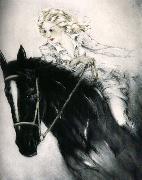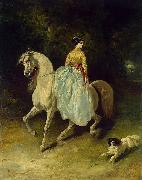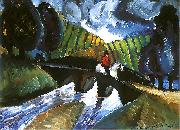Wholesale Oil Painting No Minimum |
|||||||||||
|
|
|||||||||||

|
|||||||||||
|
|
|
||||||||
Louis LcartFrench (1880-1950) Louis Icart was born in Toulouse, France. He began drawing at an early age. He was particularly interested in fashion, and became famous for his sketches almost immediately. He worked for major design studios at a time when fashion was undergoing a radical change-from the fussiness of the late nineteenth century to the simple, clingy lines of the early twentieth century. He was first son of Jean and Elisabeth Icart and was officially named Louis Justin Laurent Icart. The use of his initials L.I. would be sufficient in this household. Therefore, from the moment of his birth he was dubbed 'Helli'. The Icart family lived modestly in a small brick home on rue Traversi??re-de-la-balance, in the culturally rich Southern French city of Toulouse, which was the home of many prominent writers and artists, the most famous being Henri de Toulouse-Lautrec. Icart fought in World War I. He relied on his art to stem his anguish, sketching on every available surface. It was not until his move to Paris in 1907 that Icart would concentrate on painting, drawing and the production of countless beautiful etchings, which have served (more than the other mediums) to indelibly preserve his name in twentieth century art history. When he returned from the front he made prints from those drawings. The prints, most of which were aquatints and drypoints, showed great skill. Because they were much in demand, Icart frequently made two editions (one European, the other American) to satisfy his public. These prints are considered rare today, and when they are in mint condition they fetch high prices at auction. Art Deco, a term coined at the 1925 Paris Exposition des Arts Decoratifs, had taken its grip on the Paris of the 1920s. By the late 1920s Icart, working for both publications and major fashion and design studios, had become very successful, both artistically and financially. His etchings reached their height of brilliance in this era of Art Deco, and Icart had become the symbol of the epoch. Yet, although Icart has created for us a picture of Paris and New York life in the 1920s and 1930s, he worked in his own style, derived principally from the study of eighteenth-century French masters such as Jean Antoine Watteau, François Boucher and Jean Honor?? Fragonard. In Icart's drawings, one sees the Impressionists Degas and Monet and, in his rare watercolors, the Symbolists Odilon Redon and Gustave Moreau. In fact, Icart lived outside the fashionable artistic movements of the time and was not completely sympathetic to contemporary art. Nonetheless, his Parisian scenes are a documentation of the life he saw around him and they are nearly as popular today as when they were first produced. In 1914 Icart had met a magical, effervescent eighteen-year-old blonde named Fanny Volmers, at the time an employee of the fashion house Paquin. She would eventually become his wife and a source of artistic inspiration for the rest of his life. |
||||||||
|
|
||||||||
Amazon
Amazon Painting ID:: 63500 |
mk286 63 x 52 cm 1948 mk286 63 x 52 cm 1948 |
|||||||
|
|
||||||||
Alfred Dedreux1810-1860,French painter and draughtsman. His father was the architect Pierre-Anne Dedreux (1788-1849); Alfred's sister, Louise-Marie Becq de Fouqui?res (1825-92), was also an artist. His uncle, Pierre-Joseph Dedreux-Dorcy (1789-1874), a painter and intimate friend of Gericault, took Dedreux frequently to the atelier of Gericault whose choice of subjects, especially horses, had a lasting influence on him. During the 1820s he studied with L?on Cogniet, although his early style was more influenced by the work of Stubbs, Morland, Constable and Landseer, exposure to which probably came through Gericault and the painter Eugene Lami who lived in London in the mid-1820s. |
||||||||
|
|
||||||||
|
|
Amazon
Amazon Painting ID:: 72594 |
1848(1848)
Oil on canvas
93 x 73,5 cm
cjr 1848(1848) Oil on canvas 93 x 73,5 cm cjr |
||||||
|
|
||||||||
Alfred Dedreux1810-1860,French painter and draughtsman. His father was the architect Pierre-Anne Dedreux (1788-1849); Alfred's sister, Louise-Marie Becq de Fouqui?res (1825-92), was also an artist. His uncle, Pierre-Joseph Dedreux-Dorcy (1789-1874), a painter and intimate friend of Gericault, took Dedreux frequently to the atelier of Gericault whose choice of subjects, especially horses, had a lasting influence on him. During the 1820s he studied with L?on Cogniet, although his early style was more influenced by the work of Stubbs, Morland, Constable and Landseer, exposure to which probably came through Gericault and the painter Eugene Lami who lived in London in the mid-1820s. |
||||||||
|
|
||||||||
|
|
Amazon
Amazon Painting ID:: 73640 |
Date 1848(1848)
Medium Oil on canvas
Dimensions 93 x 73,5 cm
cyf Date 1848(1848) Medium Oil on canvas Dimensions 93 x 73,5 cm cyf |
||||||
|
|
||||||||
Zygmunt Waliszewski(1897-1936) was a Polish painter, a member of the Kapist movement. Waliszewski was born in Saint Petersburg to the Polish family of an engineer. In 1907 his parents moved to Tbilisi where Waliszewski spent his childhood. In Tbilisi began his studies at a prestigious art school. In 1908 he had his first exhibition and participated in the life of artistic avant-garde. During World War I he fought with the Russian army, returning to Tbilisi in 1917. He visited Moscow several times and became inspired by the Russian Futurists. He, later, became a member of a Futurist group. In the early 1920s, he departed for Poland, and settled in Krakew. Between 1921 and 1924 he studied at Academy of Fine Arts in Krakew in the studios of Wojciech Weiss and Jezef Pankiewicz. In 1924 he went to Paris with his avante-garde group and continued his studies in painting there under the guidance of Pankiewicz. He was a participant in the Capists' plein-air painting workshops in Cagnes, Valence, Cap Martin, and Avignon. At the Louvre, he painted copies and travesties of the works of old masters like Titian, Veronese, Velezquez, Vermeer, Goya, and Delacroix. He was also fascinated by the art of Cezanne, van Gogh, and Matisse. In 1931 he returned to Poland, residing in Warsaw, Krzeszowice, and Krakew. During this time Waliszewski designed scenery and posters, created book illustrations, drew and painted caricatures and grotesque scenes. In Krakew he befriended the Polish Formists. Waliszewski painted primarily portraits and figural compositions and landscapes of the rural countryside. He died suddenly in 1936. |
||||||||
|
|
||||||||
|
|
Amazon
Amazon Painting ID:: 95917 |
Date 1921(1921)
Medium oil on cardboard
Dimensions 38 x 51 cm (15 x 20.1 in)
ttd Date 1921(1921) Medium oil on cardboard Dimensions 38 x 51 cm (15 x 20.1 in) ttd |
||||||
|
|
||||||||
|
Zygmunt Waliszewski (1897-1936) was a Polish painter, a member of the Kapist movement. Waliszewski was born in Saint Petersburg to the Polish family of an engineer. In 1907 his parents moved to Tbilisi where Waliszewski spent his childhood. In Tbilisi began his studies at a prestigious art school. In 1908 he had his first exhibition and participated in the life of artistic avant-garde. During World War I he fought with the Russian army, returning to Tbilisi in 1917. He visited Moscow several times and became inspired by the Russian Futurists. He, later, became a member of a Futurist group. In the early 1920s, he departed for Poland, and settled in Krakew. Between 1921 and 1924 he studied at Academy of Fine Arts in Krakew in the studios of Wojciech Weiss and Jezef Pankiewicz. In 1924 he went to Paris with his avante-garde group and continued his studies in painting there under the guidance of Pankiewicz. He was a participant in the Capists' plein-air painting workshops in Cagnes, Valence, Cap Martin, and Avignon. At the Louvre, he painted copies and travesties of the works of old masters like Titian, Veronese, Velezquez, Vermeer, Goya, and Delacroix. He was also fascinated by the art of Cezanne, van Gogh, and Matisse. In 1931 he returned to Poland, residing in Warsaw, Krzeszowice, and Krakew. During this time Waliszewski designed scenery and posters, created book illustrations, drew and painted caricatures and grotesque scenes. In Krakew he befriended the Polish Formists. Waliszewski painted primarily portraits and figural compositions and landscapes of the rural countryside. He died suddenly in 1936. Amazon Date 1921(1921) Medium oil on cardboard Dimensions 38 x 51 cm (15 x 20.1 in) ttd |
||||||||
|
|
||||||||
|
Prev Next
|
||||||||
|
|
||||||||
|
Related Paintings to Zygmunt Waliszewski :. |
||||||||
|
|
||||||||
|
CONTACT US |




